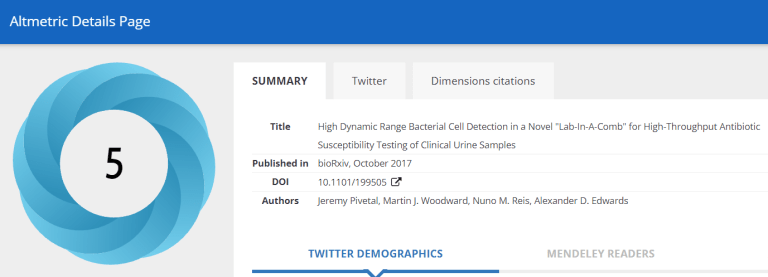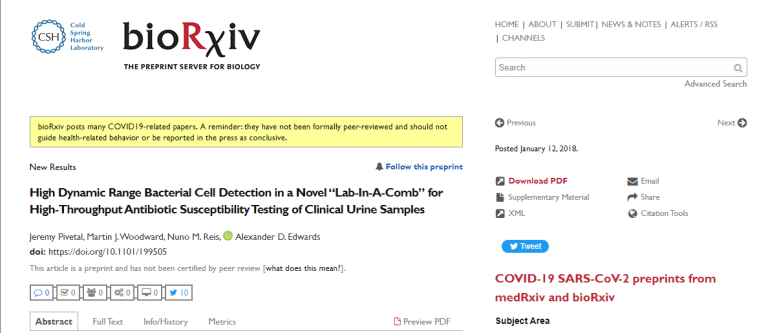
There has been a huge increase in the number of outputs uploaded to preprint servers over the last few years. Why are researchers opting for this route and what benefits does it bring?
What is a preprint?
A preprint is a full draft research paper that is shared on a publicly available platform before it has been through formal peer review. Most preprints are given a digital object identifier (DOI) which allows them to be cited by the author and others in advance of formal publication in a peer-reviewed journal.
There are several reasons why researchers choose to upload a preprint:
- Research is available faster than it would be via conventional publishing routes
- Preprints can have several versions as the manuscript evolves and improves
- The wider research community can help to improve a manuscript by suggesting changes and offering feedback
- The authors can stake a claim to a novel result or a new method in the preprint and so reduce the chances of being ‘scooped’
- Preprints can be viewed and cited ahead of the formal publication process leading to increased attention
It is important for readers of preprints to be aware that the research reported has not been peer reviewed and so should be treated with caution, particularly where medical issues are involved. Preprint servers have clear warnings about the status of publications on each output.
I talked to Dr Al Edwards about why he choses to use a preprint server for some of his work. This version of the video interview (hosted on Microsoft Stream) will only be accessible for University of Reading staff and students.
Please introduce yourself and tell us a bit about your research

My name is Al Edwards and I’m based in the School of Pharmacy at University of Reading. I’m interested in technology that could be used in biomedicines. This includes things like diagnostic testing and vaccines. I also teach undergraduates.
Why did you choose make your work available as a preprint?
There are lots of different reasons to choose to upload a manuscript as a preprint. One of the simplest ones is that it can be a very quick way to get something out and available for others to read. This has been particularly significant in recent times with the rapid growth in research on COVID19. More recently I’ve been interested in using the preprint route to make my research available especially if I’m planning to publish in a journal where the final version may not be open access because we can’t pay the article processing charge (APC) or because the publisher’s embargo on the author-accepted version in our institutional repository will be too long. By using a preprint, we can make sure that our work is available to everyone even if the final peer-reviewed, accepted and typeset version of the article isn’t available for a while.
I did have an early experience with a preprint where I had a grant proposal under review and had some comments from the reviewers that I needed to address. I was able to get a manuscript uploaded as a preprint and referenced the data in the paper in my response to the reviewers knowing that they would be able to read the preprint. I’ve no idea if it had any effect but we did receive the funding from the application so it felt like a positive boost to my preprint experience.
How did you choose the platform for hosting your preprint?
I didn’t think about it too much. I’d heard of the original preprint site arXiv and there was a subject-specific version available in bioRxiv so that seemed an appropriate place to host the preprint. Once I’d used bioRxiv and had a good experience with it, I’ve used it ever since. Once you are familiar with a site, it makes sense to stick with it.
One of the benefits of the site is that a digital object identifier is assigned to your preprint. This makes it very easy for people to cite your output and for you to track attention to the item using tools such as Altmetric.

Does it cost anything to publish a preprint?
There is no direct cost to use the preprint platform but there’s a cost associated with everything you do. In this case it is the extra work that you have to put in to make sure that you are happy with the manuscript before you upload it to the preprint server. The extra work isn’t massive but with a preprint it is going to be out there for ever and so you want it to be right. With a peer-reviewed article there are several steps in the publication process where you get to check and proofread the article prior to it being publicly available. I tend to spend a bit more time on a preprint before I upload it because I know it is going to be immediately visible. [It is possible to make changes to a preprint and update the document with versioning in place if you do notice mistakes or want to respond to feedback].
What benefits do you think there are to making the work available to everyone ahead of a formal journal submission?
For me, the driving reason is because I genuinely believe that it is the right thing to do. There are secondary reasons such as wanting to show that you’ve got progress on a particularly research problem. It can take six months for a paper to make it through a journal submission system and by using the preprint route, the information is out there much quicker. It can be very useful to have the information publicly available at an early stage, for example, if you are going to a conference you can present you findings and people can look at the full detail of the work very easily. Another reason is that if your accepted journal article is not published open access and the author-accepted manuscript is under a publisher embargo in your institutional repository, the preprint version is still accessible to interested readers. This allows greater dissemination of my work

Will you submit the paper to a journal eventually? Will the preprint version stay on the preprint server if you do?
Yes, absolutely. We have one article that is currently available as a preprint and has been through so many revisions with so many different journals but has still not been formally accepted for publication. The original preprint was made available probably four or five years ago and I think the information has probably been split up into three or four different journal articles now. One preprint is almost identical to the final peer-reviewed version that appeared in a journal so it seems to be a roll of the dice as to how the publication process works.
Have you received much feedback on your preprints? Was it helpful?
I don’t think I’ve received much feedback. I’m not sure if that is just a feature of research in my field. I don’t tend to be a proactive discusser of my work anyway. We work with lots of different people, for example, in industry, with clinicians and with other academics. Most of the discussions about the work take place within the research group. I know that other people have had useful feedback and used it to improve their manuscripts.
Would you do it again?
We’ve already got several preprints out there. I don’t do it for every paper. It tends to be on a case by case basis and sometimes there are compelling reasons to use a preprint server. If we know we are targeting a journal in a specialist field and that journal has a particularly high open access article processing fee, we might consider using a preprint in that instance. Some of the journals we are using, for example PLOS journals, are fully open access anyway and so the final peer-reviewed version will be publicly available. We have also used the Wellcome Open Research platform for our outputs. The route we choose varies from paper to paper.
Any advice for others thinking of doing the same?
I would make sure that there’s a good reason to try it. I mentioned my own example of when we just wanted the information out in the public arena quickly. Just do it and give it a go. If you are unsure and want to dip a toe in the water first, choose an article or a subject that you are not so intensively involved in and try that first. You might have a smaller paper or an article that you know is not the most important thing you’ve done and use that as a way of trying out the preprint route to see what it feels like.
It is important not to be too obsessed with getting everything perfect. When you read other people’s preprints, it is clear that you don’t expect perfection and you don’t notice typos or mistakes. Don’t be too precious about the manuscript and try to be relaxed about the process. Once you’ve done it once, you’ll find it much easier to consider again.
Al’s preprints are available on the bioRxiv preprint server. The site clearly shows which preprints have not been subject to peer review.
High Dynamic Range Bacterial Cell Detection in a Novel “Lab-In-A-Comb” for High-Throughput Antibiotic Susceptibility Testing of Clinical Urine Samples
Jeremy Pivetal, Martin J. Woodward, Nuno M. Reis, Alexander D. Edwards
bioRxiv 199505; doi: https://doi.org/10.1101/199505
This article is a preprint and has not been certified by peer review
Mixing is required for uniform reconstitution of filter-dried protein antigens in a single-injection vaccine formulation
Napawan Thangsupanimitchai, Alexander D. Edwards
bioRxiv 247403; doi: https://doi.org/10.1101/247403
Now published in Vaccine doi: 10.1016/j.vaccine.2018.07.001
High-throughput, multiplex microfluidic test strip for the determination of antibiotic susceptibility in uropathogenic E. coli with smartphone detection
Sarah H. Needs, Zara Rafaque, Wajiha Imtiaz, Partha Ray, Simon Andrews, Alexander D. Edwards
bioRxiv 2021.05.28.446184; doi: https://doi.org/10.1101/2021.05.28.446184
This article is a preprint and has not been certified by peer review

 RSS - Posts
RSS - Posts